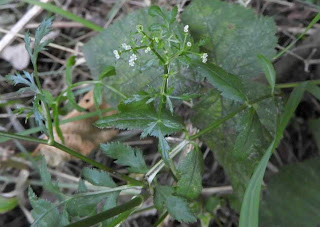These three natives of the Apiaceae family have not featured on the blog so far and thus I have the opportunity to look at them over the season from bloom to seed.
- Wild Carrot, Daucus carota
- Wild Angelica, Angelica sylvestris
- Stone Parsley, Sison amomum
Wild Carrot, Daucus carota
The umbels are often, but not always, distinguished by a central red flower which may have given rise to the popular name Queen Anne's Lace. There are two theories for this: Queen Anne pricked her finger whilst lace making or the red flower represents her head in the centre of her lace collar. The reddish flower attracted herbalists who used it as a remedy for 'falling sickness'.
Daucus is an ancient Greek name for this plant and carota simply means carrot. (D. carota ssp sativus, the garden carrot, was introduced from the Mediterranean in the fifteenth century.)
These pictures were taken on 4.8.2020 in Lydney, Gloucestershire
The other ID features can be seen below.
There are large conspicuously pinnate bracts below the umbel and as the flower head matures and the seeds ripen it balls into a distinctive shape not unlike a bird's nest. It has the name Bird's Nest in a number of counties including Wiltshire and Yorkshire. Gerard says this name was absorbed into English from the German.
The fruits are egg-shaped, flattened and with long, hooked spines.
These last two pictures were taken in the same patch of waste ground in Lydney on 9.9.2020.
Herbalists used the whole plant against gout. The seeds were a stimulant and used to treat coughs and jaundice. A poultice of the roots was used to alleviate ulcers.
Wild Angelica, Angelica sylvestris
This is common around Monmouth in damp woodlands and by streams. I look for the distinctive, bulbous, inflated sheath where the leaf and flower stalk joins the stem for the main ID feature. First photo 16.8.2020.
The stems are hollow. The individual five-petalled flowers are usually about 2 mm across.
Photo below 8.9.2020 on bank of Monmouthshire and Brecon Canal, Abergavenny.
The fruits are ridged, flattened and have two broad wings. Photo below on edge of Wye Valley woodland ride 4.9.2020.
Angelica means like an angel and here sylvestris means growing wild as opposed to the closely related garden variety Angelica archangelica.
Angelica sylvestris gives a good yellow dye and until the twentieth century was widely used as a vegetable. Local names include Ait-skeiter in Moray meaning oat shooter and referring to the use of the hollow stems by children to fire seeds at friends and Water Squirt in Somerset which presumably is similar though more uncomfortable!
Stone Parsley, Sison amomum
This finely branched, bushy plant I saw for the first time in Lydney on 4.8.2020. It is very distinctive with many small umbels of 3-6 rays often including, as shown here, a single much shorter ray. Bracts and bracteoles are present and very fine. Petals are notched. Uniquely, the crushed foliage smells of petrol.
I am very pleased to report that on 9.9.2020 the plants had set ample seed on a great tangle of stems.
This last photo shows, not very well, the probable late final blooms of 2020 but more importantly, and that is why I have included it, the lower leaves with pairs of leaflets and upper finely cut ones.
As the summer draws to a close I am unsure how many more blogs there will be this year. I have a few more plants that I have found in or near the unofficial nature reserve that is Lydney Railway Station overflow car park and some from woodland rides near where I live. I plan to do blogs to accompany the various Flower Hunts that BSBI and the Wild Flower Society organise.
Acknowledgements
Simon Harrap's Wild Flowers
Stace 4
Grigson The Englishman's Flora
Rose The Wild Flower Key
Mabey Flora Britannica












No comments:
Post a Comment